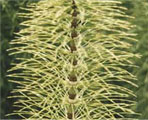Go to Back
Field horsetail (Equisetum arvense) - Health Benefits, Medicinal Properties, Uses, Dosage

Scientific name: Equisetum Arvense
Common name : Horsetail, Souring Rush
Botany
Horsetail is a pteridophyte more closelyled to ferns than to flowering plants. This rush-like nnial grows to about 1 foot and has hollow jointed s and scale-like leaves.
History
Horsetail had been used as a metal polisher the abrasive nature of its high silica content. itionally, the plant has been used as a diuretic, as anubercular drug, and in the treatment of kidney and jder disturbances.
Externally, it has been used in metics 1 and as an astringent to stop bleeding and lulate wound healing.
Chemistry
The stems of horsetail contain 5% to 8% iliea and silicic acids. The plant contains about 5% of ?aponin called equisetonin in addition to the flavone tosides isoquercitrin, equisetrin and galuteolin. The :rol fraction of E. arvense contains beta-sitosterol,pestrol' isofucosterol and trace amounts of choles?01.5 Nicotine is present in minute amounts (less than 1 m)4 but may account for a portion of the pharmacologic ivity of the plant. The cytokinin isopentenyladenosine :s been identified in fertile fronds.
Pharmacology
The plant exerts a slight diuretic livity, which is most probably due to the combined effects of equisetonin and the flavone glycosides. There are no data to support the use of horsetail in the treatment of urological disorders, tuberculosis or to enhance wound healing.
Toxicology
Horsetail has been listed as an herb of undefined safety by the FDA? Ingestion of large amounts of the fern may be toxic. Children have been reported to have been poisoned by using the stems as blow guns or whistles. In animals, the ingestion of horsetail produces muscle weakness, ataxia, weight loss, abnormal pulse rate, cold extremities and fever; these symptoms are similar to those seen in nicotine intoxication. Hay com?posed of 20% or more E. arvense produced these symp?toms in 2 to 5 weeks. Cattle appear to recognize the odor of horsetail and have been documented to have refused hay contaminated with about 12% horsetail.
Seborrheic dermatitis has been reported to have been induced by horsetail.
Summary
Horsetail continues to find some use in aTC herbal preparations. It contains small amounts of nicotine and other physiologically active compounds and is a marginally effective diuretic.
Patient information- Horsetail
Uses
Horsetail has been used as a diuretic and treatment of kidney and bladder disturbances, as an astringent to stop bleeding and stimulate healing, as an antitubercular drug and as a cosmetic component.
Side Effects
Horsetail is of undefined safety and may be toxic, especially to children.